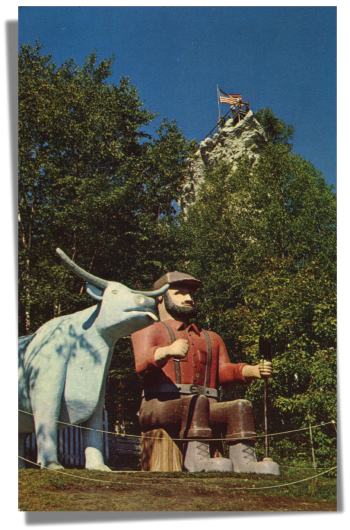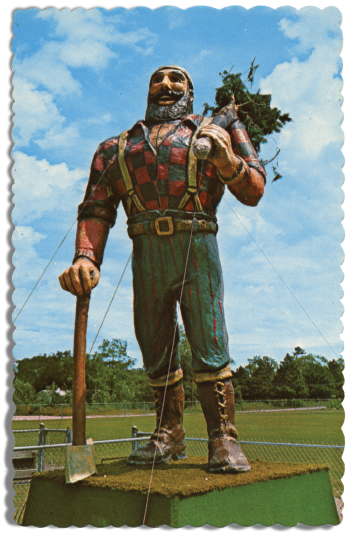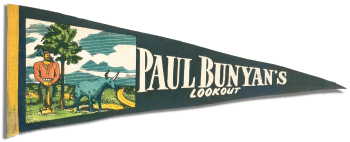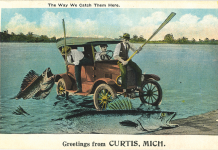 Although several states throughout the United States claim Paul Bunyan as their own, he is rightly attributed to Michigan.
Although several states throughout the United States claim Paul Bunyan as their own, he is rightly attributed to Michigan.
On Nov. 6, 2006, the state of Michigan officially designated Oscoda as the “true birthplace of the legend of Paul Bunyan as first set in ink by James MacGillivray.”
The Oscoda Press article from Aug. 10, 1906, was based on the life of Fabian Fournier, a French Canadian working in the logging camps of northern Michigan after the Civil War. MacGillivray also had spent time as a lumberjack, soaking up stories of logging lore told around campfires and potbellied stoves.
MacGillivray’s stories of a skilled lumberjack, whom he named Paul Bunyan, were told in a piece titled “Round River.” He revised and republished the article for the Detroit News Tribune in 1910, and with a larger audience, the legend of Paul Bunyan took on a life of its own.
Folklore tells of Paul Bunyan weighing 888 pounds and being taller than the tallest tree in the forest. Babe was said to measure 42 axe handles from one horn to the other.
The story of Babe the Blue Ox, Paul Bunyan’s sidekick, was created in 1914 in an advertising pamphlet for the Red River Lumber Co. of Minnesota.
 Stories of Paul Bunyan and Babe the Blue Ox grew into tall tales over the first decades of the 20th century as stories were told and retold, and books on the mythical characters were published.
Stories of Paul Bunyan and Babe the Blue Ox grew into tall tales over the first decades of the 20th century as stories were told and retold, and books on the mythical characters were published.
Paul Bunyan lore has it that it took five storks to carry the baby Paul to his mother. He grew so large that he used Saginaw Bay for a bathtub, and later enlarged it to Lake Huron. Then, with the heel of his boot, he dug out Lake Michigan and Lake Superior so Babe could drink fresh water. His lumbering crew was fed pancakes and salt pork cooked on a griddle 150 feet long, greased by the camp cook with bacon strapped on his feet as he skated merrily to and fro.
Folklore tells of Paul Bunyan weighing 888 pounds and being taller than the tallest tree in the forest. Babe was said to measure 42 axe handles from one horn to the other.
The legend of Paul Bunyan lives on in Michigan in five larger-than-life statues.
Now designated the official “birthplace” of Paul Bunyan, Oscoda’s 13-foot-4 inch statue is located in Furtaw Field, two blocks north of the center of town on U.S. 23. The statue originally was made of papier-mâché for J.L. Hudson of Detroit for a Thanksgiving Day parade. After the 1971 parade, the figure was purchased for $50 and moved to Oscoda. In 1983, the statue was restored, covered with fiberglass and repainted.
 Perhaps the Paul Bunyan and Babe statues viewed by more Michiganders than any others are those sitting at the base of Castle Rock outside of St. Ignace and seen from Interstate 75. The sitting Paul is 15 feet high and Babe is about 8 feet tall. The statues are accessed from the Castle Rock gift shop, where you can walk in Paul Bunyan’s footsteps, painted on the floor, to see Paul and Babe.
Perhaps the Paul Bunyan and Babe statues viewed by more Michiganders than any others are those sitting at the base of Castle Rock outside of St. Ignace and seen from Interstate 75. The sitting Paul is 15 feet high and Babe is about 8 feet tall. The statues are accessed from the Castle Rock gift shop, where you can walk in Paul Bunyan’s footsteps, painted on the floor, to see Paul and Babe.
 Located on U.S. 23, Spruce was the original site of other statues of these famous characters. Paul and Babe were built as a roadside attraction in the early 1950s for Paul Bunyan’s Lookout, which boasted it had “Michigan’s most scenic view,” as seen from its viewing tower. Made of concrete and steel, Paul stands 25 feet 5 inches tall and weighs 11.5 tons. Babe is 10 feet 5 inches tall and weighs 4.5 tons. In 2006, Paul and Babe were moved to the southwest corner of U.S. 23 and Nicholson Hill Road in nearby Ossineke.
Located on U.S. 23, Spruce was the original site of other statues of these famous characters. Paul and Babe were built as a roadside attraction in the early 1950s for Paul Bunyan’s Lookout, which boasted it had “Michigan’s most scenic view,” as seen from its viewing tower. Made of concrete and steel, Paul stands 25 feet 5 inches tall and weighs 11.5 tons. Babe is 10 feet 5 inches tall and weighs 4.5 tons. In 2006, Paul and Babe were moved to the southwest corner of U.S. 23 and Nicholson Hill Road in nearby Ossineke.
A 30-foot Paul Bunyan statue, originally located in Gaylord, is made of old Kaiser auto parts salvaged from Detroit. From the early 1960s, “Kaiser Paul” was a roadside attraction luring motorists off I-75 to Paul Bunyan’s Gas & Eat. After the gas station closed in the 1970s, the statue was moved to a museum in Gaylord. When the museum closed in 1980, the statue was almost scrapped, but was saved and refurbished by a Grayling realtor and moved to Grayling. In 1999, the statue of Paul was moved to Alpena Community College, repainted in the school’s team colors of maroon and silver, and became the mascot for the Lumberjacks.
The original Manistique Paul Bunyan was built in 1960 to commemorate the Manistique Centennial. The 43-foot plywood cutout was blown down in a windstorm and damaged beyond repair in the early 1970s. It was later replaced with a 15-foot fiberglass statue, standing proudly in front of the Schoolcraft County Chamber of Commerce on U.S. 2.
BLUE “Vintage View” columnists M. Christine Byron and Thomas R. Wilson reside in Grand Rapids. They are authors of the new book, “Vintage Views Along Scenic M-22 including Sleeping Bear Dunes.”







Facebook Comments